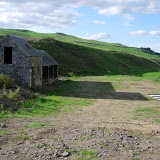Around the outside of the bale walls is constructed a non-structural frame of native larch. This serves mainly as a frame to which the external cladding will be fixed, and has the added effect of stabilizing the bale walls. This larch frame is fixed to the structure of the building wherever possible, either to window / door boxes or through the bales to the structural frame with thin battens.
The next component in the walls is possibly the most crucial to get right. Straw is a very stable and durable material, very similar in molecular make-up to wood. That's as long as it is kept dry. If moisture is allowed to penetrate the bales AND STAY THERE, the bales will rot and the whole idea of the super-insulated wall goes out the window. It is therefore essential to protect the straw from the elements, and to allow any moisture within the walls to escape. To achieve this, a breathable membrane is used over the entire outside of the walls, immediately behind the external cladding. This membrane must be as impervious to water ingress as possible, while at the same time allowing the maximum possible degree of vapour transfer from inside the walls to outside. Think of it as a Goretex coat for the straw.
There are a number of breathable membranes on the market, some designed for installation under roof-tiles or slates and some for timber-frame protection. Because of the particular demands of the strawbale wall, and the criticality of the performnce of the membrane, we decided to go for the most highly specified product we could find. This turned out to be Roofshield from the Proctor Group. With a thickness of 0.6mm and a vapour transfer rate of about 2.4 litres /m² /day it certainly stands a fighting chance of keeping the straw in pristine condition long after I've turned up my toes!
The external cladding could have been cedar imported from Canada, which boasts a typical life-span of 60 years without any need for treatment. This is quite pricey, and using imported timber would have gone rather against the project's stated aim of using local materials where possible. I was very keen to avoid any nasty chemical treatment of the cladding (typical external timber treatments use arsenic and chromium - neither of which you really want to be sprinkling on your cornflakes, or leeching into ground-water in years to come), so something naturally durable was needed. The only locally grown option was native larch. It's not as durable as slower-grown Siberian larch, but the fact that the trees that will be used are currently growing in the Bowmont Forest less than a mile from my house gives it a very cuddly feel, and saves a bundle on transportation costs, both to the environment and to my pocket. With proper detailing and careful installation, there's no reason it shouldn't still be doing its job perfectly satisfactorily in 30 years' time. That's without treatment. After a year or so it will weather to an attractive silvery colour, in much the same way that cedar does. At this point I may decide to apply a boron treatment (a completely non-toxic mineral salt) that protects very well against both woodworm and moisture.


2 comments:
Interesting to know.
I am doing research on building my own straw build retirement cottage and was suprised that you dont mention coating the bales (with clay or lime)to fireproof them!. Have you had any trouble getting fire insurance?
Post a Comment